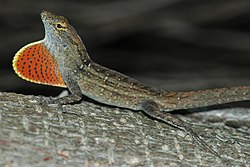Brown anole
| Brown Anole | |
|---|---|

| |
| Scientific classification | |
| Kingdom: | |
| Phylum: | |
| Class: | |
| Order: | |
| Family: | |
| Genus: | |
| Species: | A. sagrei
|
| Binomial name | |
| Anolis sagrei Cocteau in Duméril and Bibron, 1837
| |
The Brown Anole, Anolis sagrei (or Norops sagrei) also called the Bahaman Anole is a lizard native to Cuba and the Bahamas. It has been widely introduced elsewhere, and may now be found in Florida and as far north as Southern Georgia, Texas, Taiwan, Hawaii, and other Caribbean islands. Its introduction in the USA has altered the behavior and triggered a negative effect on populations of the native Green Anole, Anolis carolinensis, also called the Carolina Anole. This species is highly invasive.[1] In its introduced range it reaches exceptionally high population densities, is capable of expanding its range at an exponential rate, and both out competes and consumes many species of native lizards[2][3][4]. This is one of many other anole species and has a truly fascinating description and behaviour.
Description
The Brown Anole (also called Bahaman Anole in many pet stores) is a slender lizard reaching about 18 cm in length. Males and females differ somewhat in coloration: males have a dark stripe down their backs, females a light stripe. The mature males weigh about twice that of females. As in other anoles, the male has a brightly colored throat fan, called a dewlap, which is yellow or reddish-orange. They are territorial and the dewlap is used in territorial displays. Anoles have expanded toe pads that allow them to cling to smooth surfaces.

Behavior
Unlike the green anole which prefers foliage, the brown anole often scampers around on the ground. They are athletic creatures that run surprisingly fast, and jump many times their length. They can also climb straight up almost any surface at blinding speed. The brown anole gets used to humans and can be studied at close range.
Molting
Both the brown anole and the green anole molt (shed). But unlike a snake, they do not shed in one piece but in flakes, some quite large. The molting anole grooms itself for about 25 minutes and then eats the flakes. A problem that can present itself in captivity is that the shed skin sticks to the anole if proper humidity is not present. The unshed layer of skin can build up around the eyes area, preventing the lizard from feeding and leading to starvation. This problem can be prevented with heavy misting of the terrariums of captive specimens.
Tank Mates
Brown anoles are compatible with green anoles and long tailed lizards, though no more than one male should be in one terrarium. Brown anoles can also be compatible with Fire Bellied Toads, green tree frogs, and small geckos. Its best not to mix species due to parasites and illneses.
Food
The brown anole feeds on insects such as crickets, grasshoppers, roaches, spiders, mealworms, and waxworms. It may also eat other lizards, such as the green anole, and lizard eggs. They will also usually eat their molted skin.
References
1Kolbe, J.J., R.E. Glor, L.R. Schettino, A.C. Lara, A. Larson and J.B. Losos 2004. 'Genetic variation increases during biological invasion by a Cuban lizard Nature 431:177-181
2Campbell, T.S. 2000. Analysis of the effects of an exotic lizard (Anolis sagrei) on a native lizard (Anolis carolinensis) in Florida, using islands as experimental units. PhD Thesis, Univ. of Tennessee
3Gerber, G.P. and Echternacht, A.C. 2000. Evidence for asymmetrical intraguild predation between native and introduced Anolis lizards. Oecologia 124: 599-607.
4Losos, J.B., J.C. Marks and T. W. Schoener. 1993. Habitat use and ecological interactions of an introduced and a native species of Anolis lizard on Grand Cayman, with a review of the outcomes of anole introductions. Oecologia 95:525-532

